Holi: “The Festival of Colors Which Weaved The Fabric Of Life Into A Blanket Of Many Colors”
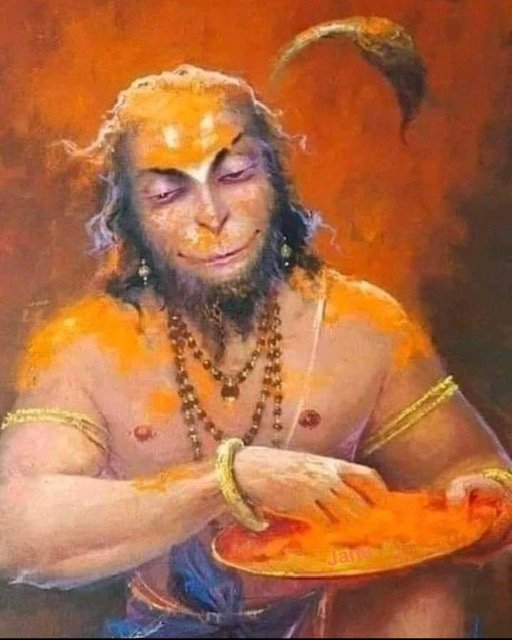

“Life Is A Rainbow Of Many Shades And Colors.”
K.J. Force
Its the reality that the vibrancy of colors brings in a lot of positivity in lives and Holi is the Hindu festival associated with colors.” Holi”, the most revered and famous Hindu festival is celebrated in India with utmost joy and enthusiasm not only in every part of India but the world over.
Holi is also called the “Festival of Love” as on this day people get to unite together forgetting all resentments. The colorful festival generally lasts for a day and a night, which starts in the evening of Purnima or the Full Moon Day in the month of Falgun or February-March. It is also celebrated with the name “Holika Dahan” or “Choti Holi” on the first evening of the festival and the following day is called Holi. However, Holi is named by different names in different parts of India.
The ritual starts by lighting up the bonfire one day before the day of Holi and this process symbolizes the triumph of good over the bad. On the day, people play with colors with their friends and families and in the evening they get together and enjoy Holl’s special delicacies.
Besides, Holi is celebrated at a time of the year when the fields are in full bloom and people are expecting a good harvest. This gives people a good reason to rejoice, make merry and submerge themselves in the holy spirit of Holi.
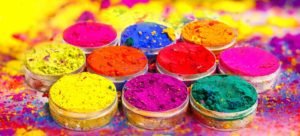
The literal meaning of the word ‘Holi‘ is “Burning” but was originally known as ‘Holika’. And, how Holi becomes the festival of color is also very interesting.
Holi festival has been referred to in various Hindu scriptures. It not only has a detailed description in the Vedas and Puranas such as Narad Purana and Bhavishya Purana but also is mentioned in Jaimini Mimansa. Early religious works such as Jaimini’s Purvamimamsa-Sutras and Kathaka-Grhya-Sutras also have many references to Holi.
Lord Krishna himself had started the tradition of playing with colors by applying them on his beloved Radha Rani and other Gopis in Mathura. Gradually, the play gained popularity with the people and became a tradition.
Hindu scriptures also have the story of Lord Shiva and Kamadeva. As per Lord Shiva scriptures, Lord of Passion Kamadeva had risked his life to revoke Lord Shiva from meditation and save the world.
There is also a popular story in Hindu scriptures. Ogress Dhundhi used to trouble children in the kingdom of Raghu and was ultimately chased away by the pranks of the children on the day of Holi. Showing their belief in the legend, children to date play pranks and hurl abuses at the time of Holika Dahan.
In Bhagavatam, Lord has explained how Holi is very significant to Hindus in the story of the demon king Hiranya Kashyap. Hiranya Kashyap wanted everybody in his kingdom to worship only him but to his great disappointment, his own son, Prahalad became an ardent devotee of Lord Narayana. Hiranya Kashyap commanded his sister, Holika to enter a blazing fire with Prahalad in her lap. Holika had a boon whereby she could enter fire without any damage on herself. However, she was not aware that the boon worked only when she enters the fire alone. As a result, she paid a price for her sinister desires, while Prahalad was saved by Lord Narayan himself due to his extreme devotion. The festival, therefore, celebrates the victory of good over evil and also the triumph of devotion.
In Bengal and Orissa, Holi Purnima is also celebrated as the birthday of Shri Chaitanya Mahaprabhu (A.D. 1486-1533).
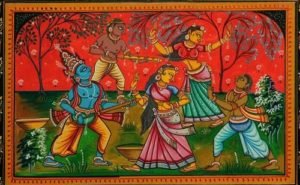
A stone inscription belonging to 300 BC found at Ramgarh in the province of Vindhya has a mention of Holikotsav on it. King Harsha, has also mentioned Holikotsav in his work Ratnavali which was written during the 7th century.
Many temples in India have many sculptures of Holi on their walls. For instance, a 16th-century panel sculpted in a temple at Hampi, capital of Vijayanagar, shows a joyous scene of Holi. The painting depicts a Prince and his Princess standing amidst maids waiting with Pichkaris(syringes) to drench the Royal couple in the colored water.
There are a lot of other paintings and murals in the temples of medieval India which provide a pictorial description of Holi. For instance, 16th century Ahmednagar painting is on the theme of Vasanta Ragini, a Spring Song or music. It shows a royal couple sitting on a grand swing, while maidens are playing music and spraying colors with pichkaris.
Similarly, a Mewar painting (1755) shows the Maharana with his courtiers. While the ruler is bestowing gifts on some people, a merry dance is on, and in the center is a tank filled with colored water. Also, a Bundi miniature shows a king seated on a tusker, and from a balcony above some damsels are showering Gulal (colored powders) on him.
Moreover, Muslim tourists Ulbaruni too has mentioned Holikotsav in their historical memories. Other Muslim writers have mentioned, that Holikotsav was not only celebrated by the Hindus but by the Muslims all over India.
It is said that a special rite is performed by married women for the happiness and well-being of their families and they worshipped full moon (Raka) during Holi.
As per the Hindu calendar, there are two ways of reckoning a lunar month “Purnimanta” and “Amanta”.
In Purnimanta, the first day starts after the full moon; and in Amanta, after the new moon. Though the Amanta reckoning is more common now, the Purnimanta was very much in vogue in the earlier days.
According to this Purnimanta reckoning, Phalguna Purnima was the last day of the year and the new year heralding the Vasanta-Ritu (with spring starting from the next day). Thus, the full moon festival of Holika gradually became a festival of merrymaking, announcing the commencement of the spring season. This perhaps explains the other names of this festival – Vasanta-Mahotsava and Kama-Mahotsava.
Rituals of the ancient colorful festival of Holi are religiously followed every year with care and enthusiasm.
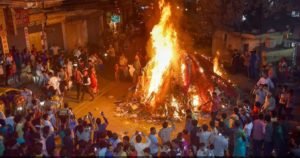
Days before the festival people start gathering wood for the lighting of the bonfire called Holika at the major crossroads of the city. This ensures that at the time of the actual celebration a huge pile of wood is collected.
On the eve of Holi, Holika Dahan takes place. Effigy of Holika, the devil-minded sister of demon King Hiranya Kashyap is placed in the wood and burnt. For, Holika tried to kill Hiranya Kashyap’s son Prahalad, an ardent devotee of Lord Narayanan. The ritual symbolizes the victory of good over evil and also the triumph of a true devotee.
Children also hurl abuses at Holika and pray pranks, as if they still try to chase away Dhundhi who once troubled little ones in the Kingdom of Prithu. Some people also take embers from the fire to their homes to rekindle their own domestic fires.
The next day is of course the main day of Holi celebrations. The day is called Dhuleti and it is on this day that the actual play of colors takes place. There is no tradition of holding puja and is meant for pure enjoyment.
The tradition of playing colors is particularly rampant in north India and even in that region, there can be no comparison to the Holi of Mathura and Vrindavan. In Maharashtra and Gujarat too, Holi is celebrated with a lot of enthusiasm and fun.
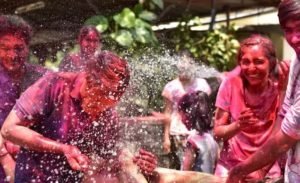
People take extreme delight in spraying color water on each other with pichkaris or pouring buckets and buckets of it. Singing Bollywood Holi numbers and dancing on the beat of dholak is also a part of the tradition.
Amidst all this activity people relish Holi delicacies like Gujiya, Mathri, Malpuas, and other traditional delicacies with great joy.
Drinks, specially Thandai laced with bhang are also an intrinsic part of the Holi festivity. Bhang helps to further enhance the spirit of the occasion but if taken in excess it might dampen it also. So caution should be taken while consuming it.
In South India, however, people follow the tradition of worshiping Kamadeva, the love god who had sacrificed his life when he shot his love arrow on Lord Shiva to break his meditation and evoke his interest in worldly affairs.
After, an eventful and fun-filled day people become a little sober in the evening and greet friends and relatives by visiting them and exchanging sweets. Holi special get-togethers are also organized by various cultural organizations to generate harmony and brotherhood in society.
No other industry has been so influenced by Holi as much as Bollywood. Creative as they are, big actors and actresses have made it a point to enjoy to the hilt when it comes to Holi.
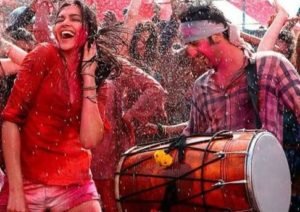
In fact, Holi at RK Studio is as famous in Mumbai as that of Mathura in UP. The trend of Holi celebration in the film industry was initiated by showman Raj Kapoor, who started the Holi celebration in a big way at his studio. A large number of industry people would gather there and play Holi, making it a star-studded event. The tradition that was followed was that anybody who came would first be greeted with a dip in the pool of colored water. Utmost care is taken that women were treated with dignity. and nobody misbehaved with them.
Various songs are being sung at the Holi festival and one can’t forget to remember the songs like Rang Barse and Holi Khele Raghubeera when he is drenched in the pious water of Holi.
Holi is called by different names in different parts of the country.

In what is known as the hub of Holi in India – Barsana, Holi is known as Lathmaar Holi. Sounds violence?? Absolutely Not, in fact, it’s a play…
The birthplace of Lord Shree Krishna’s beloved Radha Rani, Barsana celebrates Holi with extreme enthusiasm as Shree Krishna was famous for playing pranks on Radha and Gopis. In fact, it was Krishna who started the tradition of colors by first applying color on Radha’s face.
Following the tradition, men of Nandgaon, the birthplace of Shree Krishna, come to play Holi with the girls of Barsana, but instead of colors, they are greeted with sticks.
The next day, it is the turn of the men of Barsana. They reciprocate by invading Nandgaon and drenching the womenfolk of Nandgaon in colors of kyudo, naturally occurring orange-red dye, and Palash. This day, the women of Nandgaon beat the invaders from Barsana. It is a colorful sight.
Holi receives Dulandi’s name in the rich agricultural state of Haryana. Here, Bhabhi the brother’s wife gets an upper hand on the day of Holi. And, Devar’s, husband’s younger brothers need to watch out.
The Bhabhi’s on this day get a social sanction on Holi to beat their Devar’s and make them pay the price of all the pranks they played on them for the entire year. Bhabhi’s roll up their saris in the form of a rope in mock rage, and give a good run to their Devar’s.
In the evening, Devar’s are supposed to bring sweets for their dear Bhabhi.
Besides, there is also a tradition of breaking the pot of buttermilk hung high in the street by forming a human pyramid.
Holi gets this joyful name in the prosperous state of Punjab. The festival is celebrated in an entirely different manner, its meaning and significance also shift a little here.
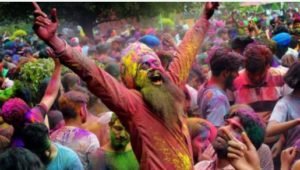
Hola Mohalla is actually an annual fair that is organized on a large scale at Anandpur Sahib in Punjab on the day following the festival of Holi. The practice of holding a fair of this kind was initiated by Guru Gobind Singh Ji, the tenth Sikh guru. The purpose of the fair was to physically strengthen the Sikh community by holding military exercises and mock battles.
The festival is celebrated for three consecutive days, in which members of the Sikh community display their physical strength by performing dare-devil acts like bareback horse-riding, standing erect on two speeding horses, Gatka (mock encounters), tent pegging, etc. This is followed by a music and poetry competition to lighten the charged-up atmosphere.
A number of durbars are also held where Sri Guru Granth Sahib is present and kirtan and religious lectures take place. This helps strengthen the soul of the community. On the last day a long procession, led by Panj Payara, starts from Takht Keshgarh Sahib, one of the five Sikh religious seats, and passes through various important gurdwaras like Qila Anandgarh, Lohgarh Sahib, Mata Jitoji and terminates at the Takht.
For people visiting Anandpur Sahib, langar (voluntary community kitchens) are organized by the local people as a part of Sewa (community service). Raw materials like wheat flour, rice, vegetables, milk, and sugar are provided by the villagers living nearby. Women volunteer to cook and others take part in cleaning the utensils. Traditional cuisine is served to the pilgrims who eat while sitting in rows on the ground.
Holi by the name of Basant Utsav is celebrated with fervor in the state of West Bengal. The tradition of Vasantotsav, meaning Spring Festival was started by poet and Nobel laureate Rabindranath Tagore at Shanti Niketan, the University he founded.
What is appreciated is the grace and dignified manner in which Vasant Utsav is celebrated. Boys and girls joyfully welcome Spring, the season of hope with songs, dance, chanting of hymns in the serene ambiance of Shanti Niketan.
Holi is also known by the name of Dol Purnima in West Bengal.
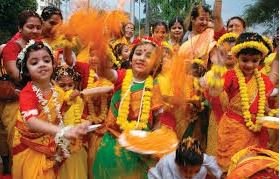
Early in the morning, on the Dol Purnima day students dress up in saffron-colored clothes and wear garlands of fragrant flowers. They sing and dance to the accompaniment of musical instruments presenting an enchanting view to the onlookers and a memory to cherish for years.
The festival is also known as “Dol Jatra”, “Dol Purnima” or the “Swing Festival”. The festival is celebrated in a dignified manner by placing the idols of Krishna and Radha on a picturesquely decorated palanquin which is then taken around the main streets of the city. The devotees take turns to swing them while women dance around the swing and sing devotional songs. Throughout the procession men keep spraying colored water and color powder, ‘Abeer’ at them.
People of Maharashtra commonly know this festival of colors by the name of Rang Panchami as the play of colors is reserved for the fifth day here. Locals of Maharashtra also know Holi as Shimoga.
The festival is particularly popular amongst fisher folk. They celebrate it on a large scale and revel in the festivities by singing, dancing, and merry-making. This special dance provides them the means to release all their repressed feelings, needs, and desires. People also utter a sound through their mouths in a peculiar fashion by striking their mouths with the back of their hands.
The fun-filled and enthusiastic people of Goa know Holi by the name of Shimgo in their local dialect Konkani. Here too, people play with bright colors to welcome the arrival of spring. This is followed by a local delicacy called shagoti and sweet preparations. Some people also know Holi by the name of Rang Panchami.
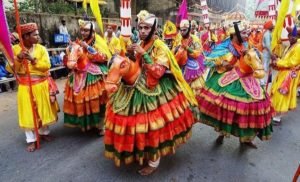
The most interesting facet of Holi or Shimgo in Goa is the huge procession that is carried out in its capital city of Panjim. The high point of this is performances of troupes and cultural drama depicting cultural-religious stories. People from all walks of life participate in this festival with great enthusiasm.
As in the state of Tamil Nadu, people worship Kamadeva for his supreme sacrifice on the occasion of Holi. People know Holi by three different names Kaman Pandigai, Kamavilas and Kama-Dahanam.
In Tamil Nadu songs are sung on Holi depicting Rati’s, Kamadeva’s wife’s extreme sorrow and people offer sandalwood to Kamadeva to ease the pain of burning. People also believe that Kamadeva was revived on the day of Holi and hence celebrate the festival in his name.
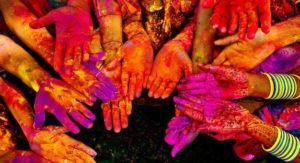
As Sanatana Dharma is the oldest civilization on earth, every Hindu festival has a very scientific reason. And same applies to the festival Holi.
It is interesting to note that the festival of Holi is significant for our lives and body in many other ways than providing joy and fun. Our forefathers started the trend of celebrating Holi at such a scientifically accurate time. Because Holi comes at a time of the year when people have a tendency to feel sleepy and lazy which is natural due to the change from the cold to the heat in the atmosphere. To counteract this tardiness of the body, people sing loudly or even speak loudly.
The colors when sprayed on the body have a great impact on it. Scientists believe the liquid dye or Abeer penetrates the body and enters into the pores. It has the effect of strengthening the ions in the body and adds health and beauty to it.
Another scientific reason for celebrating the Holi pertains to the tradition of Holika Dahan. The mutation period of winter and spring induces the growth of bacteria in the atmosphere as well as in the body. When Holika is burnt, the temperature rises to about 145 degrees Fahrenheit. Following the tradition when people perform Parikrama (circumambulation or going around) around the fire, the heat from the fire kills the bacteria in the body thus, cleansing it.
The way Holi is celebrated in the south, the festival also promotes good health. For, the day after the burning of Holika people put ash (Vibhuti) on their forehead and they would mix Chandan (sandal paste) with the young leaves and flowers of the Mango tree and consume it to promote good health.
Moreover, playing with colors helps to promote good health as colors are said to have a great impact on our body and our health. Physicians believe that for a healthy body, colors have an important place besides the other vital elements. Deficiency of a particular color in our body causes ailment, which can be cured only after supplementing the body with that particular color.
People also clean up their houses on Holi which helps in clearing up the dust and mess in the house and getting rid of mosquitoes and others pests. A clean house generally makes the residents feel good and generate positive energies.
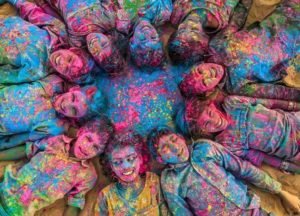
Celebration of the various legends associated with Holi reassure the people of the power of the truth as the moral of all these legends is the ultimate victory of good over evil. It is also de facto that extreme devotion to Lord pays as Lord always takes his true devotee in his shelter.
All our scriptures guide us that Lord Devotees should help the people to follow good conduct in their lives and believe in the virtue of being truthful. It has become extremely important in a modern-day society when so many people resort to evil practices for small gains and torture one who is honest. Holi helps the people to believe in the virtue of being truthful and honest and also to fight away evil.
We should revitalize our relationships and strengthen emotional bonds between people. Lord also teaches us not to differentiate between the rich and poor and there should be the spirit of bonhomie and brotherhood
DISCLAIMER: The author is solely responsible for the views expressed in this article. The author carries the responsibility for citing and/or licensing of images utilized within the text.
